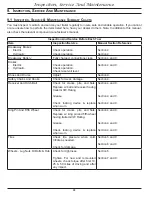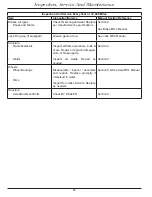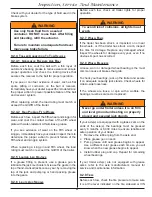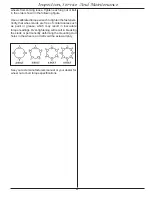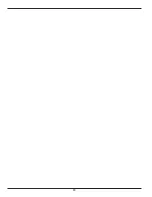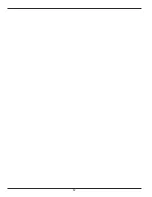
47
Check with your dealer for the type of fluid used in the
brake system.
^
WARNING
Use only fresh fluid from a sealed
container. DO NOT reuse fluid. After filling
and bleeding, refill the actuator.
Failure to maintain an adequate fluid level
may cause brake failure.
9.2.4 t
raIler
c
onnectIon
t
o
t
ow
V
ehIcle
9.2.4.1 g
ooSeneck
r
eceIVer
a
nd
B
all
Before each tow, coat the ball with a thin layer of
automotive bearing grease to reduce wear and ensure
proper operation; and check the locking device that
secures the receiver to the ball for proper operation.
If you see or can feel evidence of wear, such as flat
spots, pitting or corrosion, on the ball or receiver,
immediately have your dealer inspect them to determine
the proper action to prevent possible failure of the ball
and receiver system.
When replacing a ball, the load rating must match or
exceed the GVWR of the trailer.
9.2.4.2 k
Ing
p
In
a
nd
f
Ifth
w
heel
Before each tow, inspect the fifth wheel and kingpin for
wear, and coat the contact surface of the fifth wheel
plate with water-resistant Lithium-base grease.
If you see evidence of wear on the fifth wheel or
kingpin, immediately have your dealer inspect them to
determine the proper action to prevent failure of the
fifth wheel and kingpin system.
When replacing a king pin and fifth wheel, the load
rating must match or exceed the GVWR of the trailer.
9.2.5 l
andIng
l
eg
o
r
j
ack
If a grease fitting is present, use a grease gun to
lubricate the jack mechanism. Grease the gears in the
top of hand-cranked jacks once a year, by removing the
top of the jack and pumping or hand packing grease
into the gears.
9.2.6 l
IghtS
a
nd
S
IgnalS
Before each tow, check all trailer lights for proper
operation.
^
WARNING
To avoid risk of collisions, all lights must
work.
9.2.7 w
heel
r
ImS
If the trailer has been struck, or impacted, on or near
the wheels, or if the trailer has struck a curb, inspect
the rims for damage. Replace any damaged wheel.
Inspect the wheels for damage every year, even if no
obvious impact has occurred.
9.2.8 w
heel
B
earIngS
A loose, worn or damaged wheel bearing is the most
common cause of brakes that grab.
To check your bearings, jack up the trailer and secure
it on adequate capacity jack stands. Check wheels for
side-to-side looseness.
If the wheels are loose, or spin with a wobble, the
bearings must be serviced or replaced.
^
WARNING
Never go under trailer unless it is on firm
and level ground and resting on properly
placed and secured jack stands.
If your axle(s) are equipped with a grease zerk on the
ends of the axle(s), the bearings must be greased
every 6 months or 6,000 miles to ensure reliable and
safe operation of your trailer.
1.
Remove the rubber plug from the axle end.
2.
Place grease gun on zerk.
3.
Pump grease until new grease begins to appear.
Use a different color grease each time so you will
know when the new grease begins to appear.
4.
Install rubber plug and cap. Repeat for remaining
wheel bearings.
If your trailer axle(s) are not equipped with grease
zerks, refer to the axle manufacturer’s manual for
service and maintenance information.
9.2.9 t
IreS
Before each tow, check the tire pressure to make sure
it is at the level indicated on the tire sidewall or VIN
Inspection, Service And Maintenance
Содержание Gooseneck SERIES
Страница 13: ... 13 2 2 17 Safety Warning Labels On Your Trailer Safety ...
Страница 50: ... 50 ...
Страница 51: ... 51 ...
Страница 52: ... 52 ...










